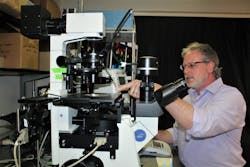Quantum-Dot Sensor Monitors Brain Functions
An interdisciplinary team of researchers at the Naval Research Laboratory developed the first sensor that relies on quantum dots to monitor the brain by reading its electrical signals, resulting in a less-invasive process than the usual nanowire techniques. Monitoring the brain in this way can lets doctors better diagnose brain disorders that affect soldiers and sailors, such as traumatic brain injury.
The primary way physicians understand how the brain works is by looking at neurons’ electrical activity in the brain, which is how neurons communicate with one another. “The currently available set of probes and materials for monitoring brain activity have limitations such as limited light output, or they are inherently toxic,” says Igor Medintz, the Navy’s Senior Scientist for Biosensors and Biomaterials at NRL. According to Medintz, developing new materials to monitor at neuron communication has been one avenue to address this problem.
“But you need a material that can do two things,” notes James Delehanty, team leader. “The material needs to react to relay that electrical process [in the brain] and give you some type of output you can see through a microscope.”
Delehanty demonstrates the use of the cell microinjection system.
The team at NRL knew that quantum dots (QDs) would be good candidates for this application, thanks to their ability to give off light—something you can see—along with their ability to respond to electrical signals routing through the brain. QDs are much like “artificial atoms,” having rare properties that can be engineered for specific applications (such as the emitted light’s color) by controlling their size and tailoring their sensitivity to electric or magnetic fields by manipulating their structure and composition.
“Quantum dots have a lot of advantages,” said Delehanty. “They’re much brighter, much more stable, and they can be designed to react to the neurons’ electrical processes appropriately.”
The researchers used these advantages and combined them with a nanomaterial called a carbon buckyball or fullerene through the use of a peptide to create a sensor able to attach itself to a nerve cell’s membrane. The resulting sensor emits different levels of light in response to the brain’s changing electrical signals.
“When the sensor sits in the cell membrane and there’s an electrical pulse, the quantum dot goes from bright to dim, then brightens as the pulse passes,” says Delehanty. “In the brain, there are lots of these events happening in a confined space, so you see a time-resolved brightness or luminescence change."
The NRL quantum-dot sensor has been demonstrated and used through a collaboration with the Howard Hughes Medical Institute. This partnership also highlights NRL’s ability to team with outside academic and scientific institutions in pursuit of cutting-edge research.
According to Delehanty, this project feeds into the DoD’s larger interest in studying the brain. “There are huge research initiatives underway to learn how the brain works,” notes Delehanty. “And the first part of these initiatives focuses on developing the tools to be able to see the brain. Once we can see the brain at the smallest level and largest levels, we can begin examining how the brain works.”


